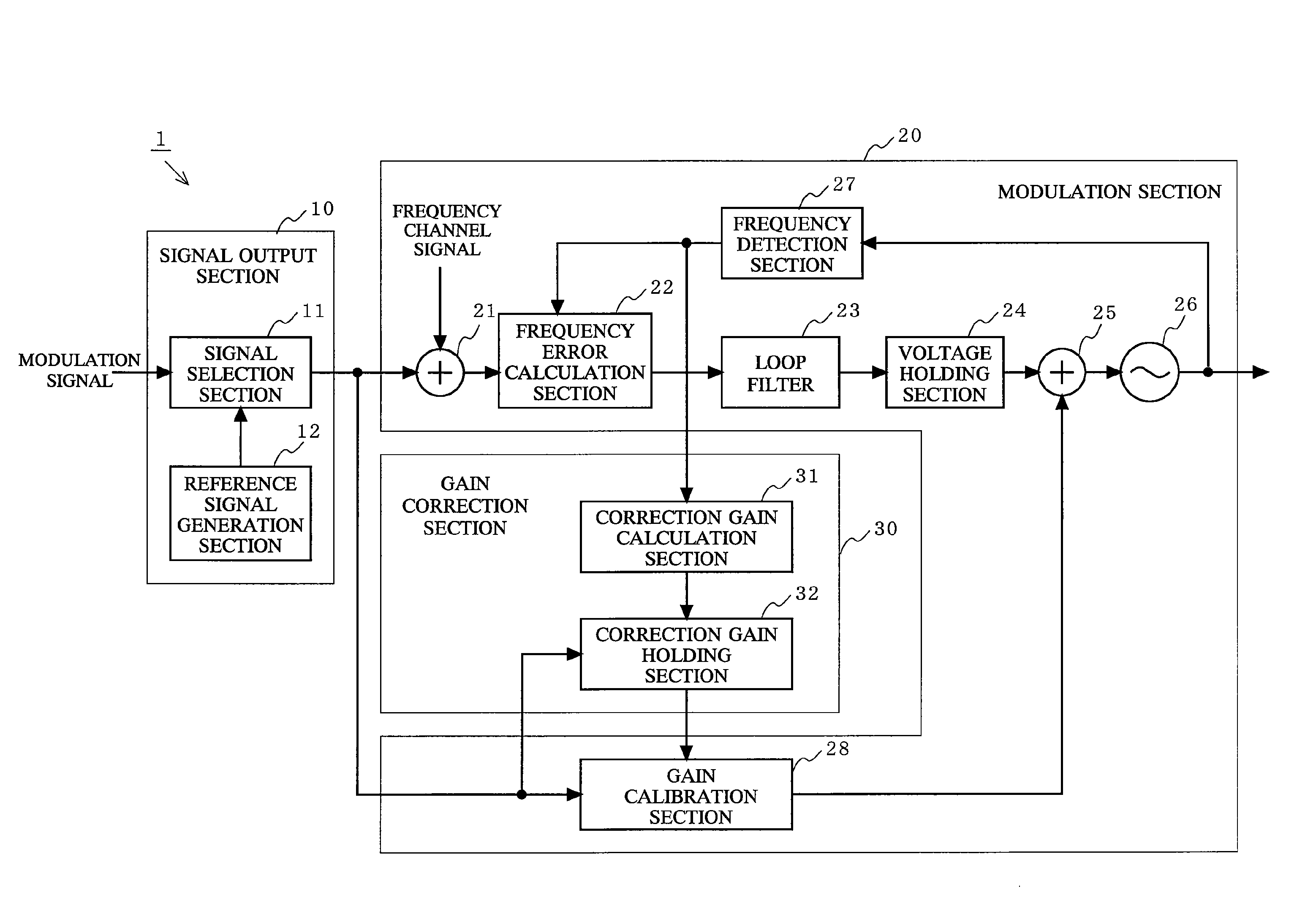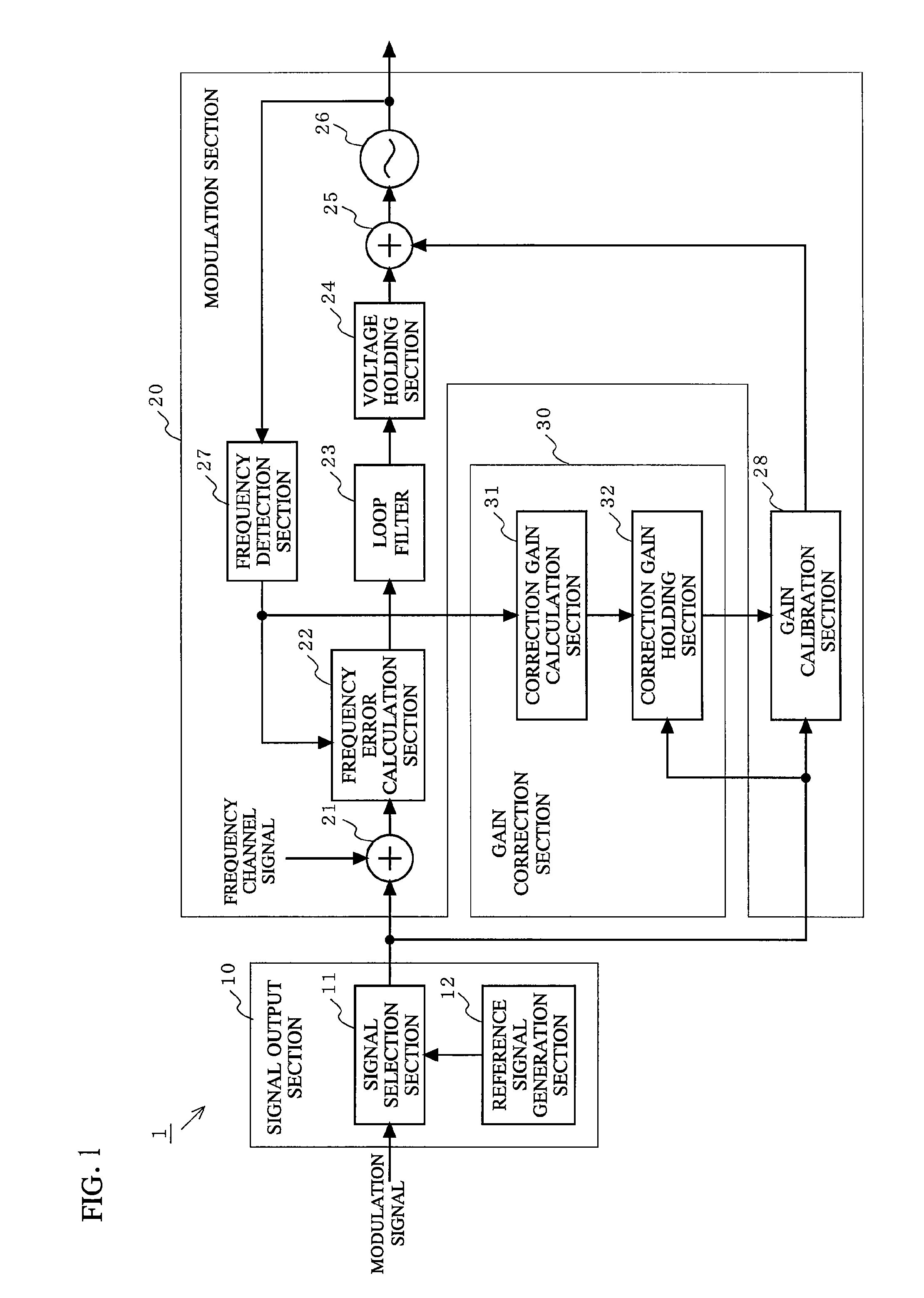Two point modulator using voltage control oscillator and calibration processing method
a voltage control oscillator and two-point modulator technology, applied in angle modulation, automatic control, electrical apparatus, etc., can solve the problems of long time for calibration processing on the vco, inability to obtain wideband frequency characteristics, distortion of output, etc., to achieve short time and optimal
- Summary
- Abstract
- Description
- Claims
- Application Information
AI Technical Summary
Benefits of technology
Problems solved by technology
Method used
Image
Examples
first embodiment
[0047]FIG. 2 is a flowchart showing a process of a first embodiment of a calibration operation performed by the two-point modulator 1 of the present invention.
[0048]First, signal selection section 11 selects a state where neither a modulated signal nor a reference signal is inputted thereto. A frequency channel signal of a desired frequency f is inputted to the frequency error calculation section 22, the feedback circuit is brought into a closed loop state (step S201), and then a lockup voltage, which is a voltage used when the VCO 26 is locked up in a state where a non-modulated signal is used, is measured (step S202). The lockup voltage is held in the voltage holding section 24 (step S203). Thereafter, the loop filter 23 is deactivated and the lockup voltage held by the voltage holding section 24 is fixedly supplied as a voltage to be outputted to the adding section 25, thereby bringing the feedback circuit into an open loop state (step S204).
[0049]Next, after the feedback circuit...
second embodiment
[0063]A process of a second embodiment of a calibration operation performed by the two-point modulator 1 of the present invention is basically similar to the process shown in FIG. 2, except the processing of step S206. Hereinafter, the second embodiment will be described focusing on the processing of step S206.
[0064]When the gain calibration section 28 sets the correction gain value to an initial value (step S205), the reference signal generation section 12 generates a reference signal having a pulse pattern shown in FIG. 7, and outputs the generated reference signal to the correction gain holding section 32 and the gain calibration section 28. FIG. 7 is a diagram for explaining the reference signal used in the second embodiment for measuring the correction gain value of the VCO 26.
[0065]The reference signal shown in FIG. 7 includes a zero-th pulse which is a null signal representing no frequency information, a first pulse having a positive pulse value +A which represents a frequenc...
third embodiment
[0075]A process of a third embodiment of a calibration operation performed by the two-point modulator 1 of the present invention is basically similar to the process shown in FIG. 2, except the processing of step S206. Hereinafter, the third embodiment will be described focusing on the processing of step S206.
[0076]When the gain calibration section 28 sets the correction gain value to an initial value (step S205), the reference signal generation section 12 generates a reference signal having a pulse pattern shown in FIG. 10, and outputs the generated reference signal to the correction gain holding section 32 and the gain calibration section 28. FIG. 10 is a diagram for explaining the reference signal used in the third embodiment for measuring the correction gain value of the VCO 26.
[0077]The reference signal shown in FIG. 10 includes a zero-th pulse which is a null signal representing no frequency information, a first pulse having a positive pulse value +A1 which represents a frequen...
PUM
 Login to View More
Login to View More Abstract
Description
Claims
Application Information
 Login to View More
Login to View More - R&D
- Intellectual Property
- Life Sciences
- Materials
- Tech Scout
- Unparalleled Data Quality
- Higher Quality Content
- 60% Fewer Hallucinations
Browse by: Latest US Patents, China's latest patents, Technical Efficacy Thesaurus, Application Domain, Technology Topic, Popular Technical Reports.
© 2025 PatSnap. All rights reserved.Legal|Privacy policy|Modern Slavery Act Transparency Statement|Sitemap|About US| Contact US: help@patsnap.com



